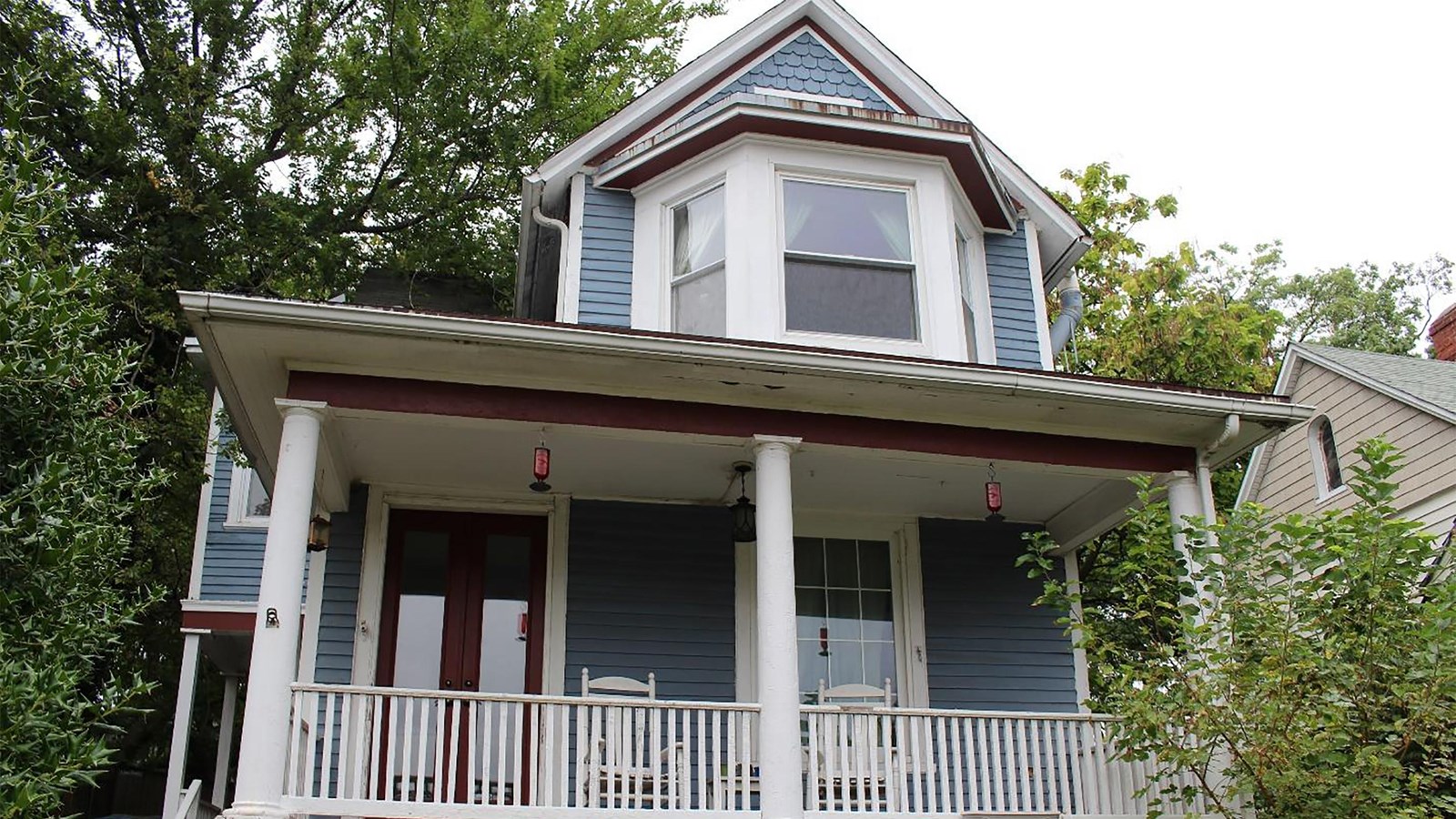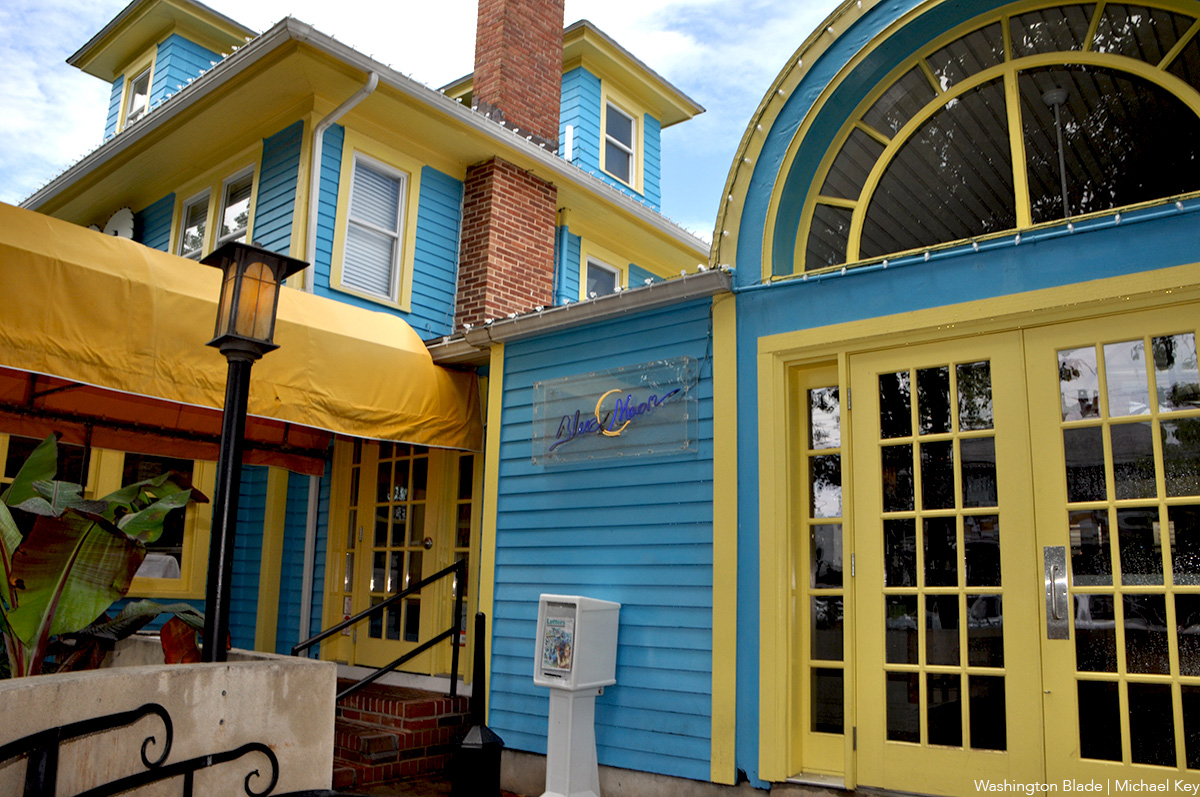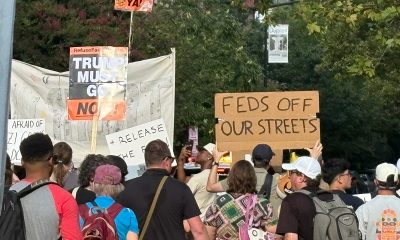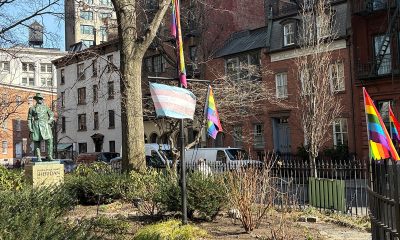Local
Will the Slowe-Burrill House become a National Landmark?
Process raises questions about what constitutes LGBTQ history

On Oct. 5, 2020, the Slowe-Burrill House was put on the National Register for Historic Places for its association with Lucy Diggs Slowe, most recognized for her work as the first Dean of Women at Howard University, where she served from 1922 until her death in 1937.
Even before her appointment at Howard, she boasted an extraordinary vitae. As an undergraduate at Howard, she was a founding member of the first sorority for African-American women. After graduating valedictorian of her class, and earning her master’s at Columbia University, Slowe took a position teaching at the Armstrong Manual High School in D.C., where she so impressed the school board that they appointed her to found the first-ever junior high school for African Americans in the national capital region.
As Tamara Beauboeuf-Lafontant describes in her book-length study of Slowe’s deanship, “To Live More Abundantly,” Slowe’s tenure at Howard was defined by her advocacy for what she called the “New Howard Woman” in her inaugural address to the students, a woman who was “of extreme culture and refinement.” She worked tirelessly, often at odds with the administration, to encourage the women of Howard to pursue the social sciences, not just the liberal arts thought to befit future mothers, and to explore careers outside of teaching, which was, as Slowe described, “the only occupation which is open to them with few handicaps.” Slowe was unsatisfied with the absence of women’s housing on campus, which she argued was necessary as a “laboratory for practical education in human relationships,” and orchestrated funding from Congress to build three new dormitories for a Women’s Campus. Slowe was so successful in her projects that, as one student reported, “we spoke among ourselves of our dean, not as Dean Slowe but as Dean Swift.”
Given Slowe’s remarkable life, and the National Park Service’s registration of her house as a historic site in recognition of that life, one would be forgiven for wondering why the site is titled the “Slowe-Burrill House” after both Slowe and her life partner, Mary Burrill. While the National Register nods to Burrill’s career as a teacher and playwright, it makes clear her historical significance is primarily as Slowe’s partner. The title of the site is less in recognition of Burrill herself than of Slowe and Burrill’s same-sex relationship at a time in which it would have been especially risky for a public figure like Slowe. While Slowe and Burrill were able to frame their partnership within 19th century ideals of romantic friendship, those ideals were coming under increasing scrutiny by the 20th century, which saw the pathologizing of women’s intimate relationships in the growing medical discourse around sexuality.
Now the Slowe-Burrill House is up for nomination as a National Landmark at the next meeting of the National Historic Landmark Committee this spring. Dr. Susan Ferentinos, a specialist in LGBTQ public history, was contacted by the National Park Service back in 2016 to help identify potential landmarks related to LGBTQ history. Ferentinos noticed there was a particular absence of LGBTQ landmarks in D.C., and put together a shortlist of sites including the Slowe-Burrill House. Ferentinos has been working through that list since, most recently preparing a national landmark nomination for the Furies Collective, which the Blade reported on in November.
But the bar for a National Historic Landmark is far higher than for the National Register of Historic Places. Only 3% of items on the National Register earn a further designation as a National Historic Landmark, and the priority for federal funding that goes with it. Will the Slowe-Burrill House meet that higher bar?
One way a site gets approved is by association with a nationally significant figure, and Lucy Diggs Slowe certainly has the national standing required. As Dean of Women, her work extended far beyond the campus of Howard University. Slowe established the National Association of College Women, an alumnae organization for Black women college graduates across the country. Under her leadership, the organization raised money to help young Black women attend college, worked to institutionalize gender equity in higher education, and led initiatives to foster interracial understanding with white college alumnae. Slowe was the first Black member of the National Association of Deans of Women, where she endlessly fielded her white peers’ concerns with racial matters on campus. And Slowe served on the national board of Young Women’s Christian Association, which gave her the connections she needed to go on a cross-country tour of colleges to talk about race relations among college women.
But if Slowe’s impact on women’s and African-American history on a national level is undoubtable, things are less clear when it comes to her mark on LGBTQ history. Slowe’s relationship with Burrill was a private matter, and not one she sought to advertise on the national stage. If Slowe’s house becomes a national landmark, will it still be as the Slowe-Burrill House? Or just the Slowe House?
That question arose early in Ferentinos’s work with Kathryn Smith, the National Historic Landmarks Coordinator for the Capital Region. On an early draft for the nomination, Dr. Ferentinos got the feedback that perhaps Slowe wasn’t really a national figure in LGBTQ history, and that they should be focusing on other criteria of national significance. But Ferentinos, who made it clear she does not speak for the National Park Service, vehemently disagreed. “I said to [Kathryn Smith], I feel so strongly that this property is significant to LGBTQ history. What this feedback is telling me is that I haven’t done a good enough job yet. I’m willing to do a couple extra rounds of revision … in order to do this right because it is really important.”
As Dr. Ferentinos sees it, LGBTQ history is often simply figured as a history of political activism, which excludes the huge number of folks who managed to carve out a professional life while leading a life as LGBTQ, however private it may have been. And if she’s ever going to get a chance to nominate someone who represents this broader vision of LGBTQ history, it’s Slowe.
It is well known that at the end of her career, Slowe had a protracted fight with the president of Howard University, Mordecai Johnson. Despite having arranged in her contract to live off-campus, as all male deans did, Johnson was intent on forcing Slowe to live on campus, so that she could better supervise the students — and from a shanty next to the college dump. Slowe fought Johnson to defend her contract right up until her death. While Slowe was dying from pneumonia in her bed, instead of appointing an interim dean, Johnson issued her an ultimatum: report to work or be replaced. Burrill refused to answer the demand, and a replacement was named. Slowe died a month later, on Oct. 21, 1937.
As Beauboeuf-Lafontant describes it in her book, this story is yet another example of Slowe’s fight for gender equality, to have the rights and privileges afforded to male deans. But while Beauboeuf-Lafontant makes no mention of the role Slowe’s relationship with Burrill played in this tale, Ferentinos thinks it was a central factor. “There are memos that could seem very innocent [to] a historian who is not trained in LGBTQ history,” Ferentinos explained. There would be a memo, for instance, asking Slowe to give an account of the financial hardship the move would cause her. “It could seem like a bureaucratic crossing of Ts,” Ferentinos said. “Or it could be read as calling her bluff. It wouldn’t cause her a financial hardship, it would cause her partner a financial hardship.”
Kathryn Smith reported being satisfied with Ferentinos’s revisions of the nomination, but was cautious about predicting whether or not they would succeed. “We are supportive of the arguments she’s making, but it will ultimately be up to the NHL [National Historic Landmark] committee to determine and to make the recommendation as to whether this argument will stand.” At stake here is more than just Slowe. Is LGBTQ history just the history of figures who publicly advocated the rights of queer people? Or is it also the history of those who worked to build whatever life they could, no matter how private they kept it?
(CJ Higgins is a postdoctoral fellow with the Alexander Grass Humanities Institute at Johns Hopkins University.)
Rehoboth Beach
Rehoboth’s Blue Moon is for sale but owners aim to keep it in gay-friendly hands
$4.5 million listing includes real estate; business sold separately

Gay gasps could be heard around the DMV earlier this week when a real estate listing for Rehoboth Beach’s iconic Blue Moon bar and restaurant hit social media.
Take a breath. The Moon is for sale but the longtime owners are not in a hurry and are committed to preserving its legacy as a gay-friendly space.
“We had no idea the interest this would create,” Tim Ragan, one of the owners, told the Blade this week. “I guess I was a little naive about that.”
Ragan explained that he and longtime partner Randy Haney are separating the real estate from the business. The two buildings associated with the sale are listed by Carrie Lingo at 35 Baltimore Ave., and include an apartment, the front restaurant (6,600 square feet with three floors and a basement), and a secondary building (roughly 1,800 square feet on two floors). They are listed for $4.5 million.
The bar and restaurant business is being sold separately; the price has not been publicly disclosed.
But Ragan, who has owned the Moon for 20 years, told the Blade nothing is imminent and that the Moon remains open through the holidays and is scheduled to reopen for the 2026 season on Feb. 10. He has already scheduled some 2026 entertainment.
“It’s time to look for the next people who can continue the history of the Moon and cultivate the next chapter,” Ragan said, noting that he turns 70 next year. “We’re not panicked; we separated the building from the business. Some buyers can’t afford both.”
He said there have been many inquiries and they’ve considered some offers but nothing is firm yet.
Given the Moon’s pioneering role in queering Rehoboth Beach since its debut 44 years ago in 1981, many LGBTQ visitors and residents are concerned about losing such an iconic queer space to redevelopment or chain ownership.
“That’s the No. 1 consideration,” Ragan said, “preserving a commitment to the gay community and honoring its history. The legacy needs to continue.” He added that they are not inclined to sell to one of the local restaurant chains.
You can view the real estate listing here.

The Comings & Goings column is about sharing the professional successes of our community. We want to recognize those landing new jobs, new clients for their business, joining boards of organizations and other achievements. Please share your successes with us at [email protected].
Congratulations to Tristan Fitzpatrick on his new position as Digital Communications Manager with TerraPower. TerraPower creates technologies to provide safe, affordable, and abundant carbon-free energy. They devise ways to use heat and electricity to drive economic growth while decarbonizing industry.
Fitzpatrick’s most recent position was as Senior Communications Consultant with APCO in Washington, D.C. He led integrated communications campaigns at the fourth-largest public relations firm in the United States, increasing share of voice by 10 percent on average for clients in the climate, energy, health, manufacturing, and the technology. Prior to that he was a journalist and social media coordinator with Science Node in Bloomington, Ind.
Fitzpatrick earned his bachelor’s degree in journalism with a concentration in public relations, from Indiana University.
Congratulations also to the newly elected board of Q Street. Rob Curis, Abigail Harris, Yesenia Henninger, Stu Malec, and David Reid. Four of them reelected, and the new member is Harris.
Q Street is the nonprofit, nonpartisan, professional association of LGBTQ+ policy and political professionals, including lobbyists and public policy advocates. Founded in 2003 on the heels of the Supreme Court’s historic decision in Lawrence v. Texas, when there was renewed hope for advancing the rights of the LGBTQ community in Washington. Q Street was formed to be the bridge between LGBTQ advocacy organizations, LGBTQ lobbyists on K Street, and colleagues and allies on Capitol Hill.
District of Columbia
New queer bar Rush beset by troubles; liquor license suspended
Staff claim they haven’t been paid, turn to GoFundMe as holidays approach

The D.C. Alcoholic Beverage and Cannabis Board on Dec. 17 issued an order suspending the liquor license for the recently opened LGBTQ bar and nightclub Rush on grounds that it failed to pay a required annual licensing fee.
Rush held its grand opening on Dec. 5 on the second and third floors of a building at 2001 14 Street, N.W., with its entrance around the corner on U Street next to the existing LGBTQ dance club Bunker.
It describes itself on its website as offering “art-pop aesthetics, high-energy nights” in a space that “celebrates queer culture without holding back.” It includes a large dance floor and a lounge area with sofas and chairs.
Jackson Mosley, Rush’s principal owner, did not immediately respond to a phone message from the Washington Blade seeking his comment on the license suspension.
The ABC Board’s order states, “The basis for this Order is that a review of the Board’s official records by the Alcoholic Beverage and Cannabis Administration (ABCA) has determined that the Respondent’s renewal payment check was returned unpaid and alternative payment was not submitted.”
The three-page order adds, “Notwithstanding ABCA’s efforts to notify the Respondent of the renewal payment check return, the Respondent failed to pay the license fee for the period of 2025 to 2026 for its Retailer’s Class CT license. Therefore, the Respondent’s license has been SUSPENDED until the Respondent pays the license fees and the $50.00 per day fine imposed by the Board for late payment.”
ABCA spokesperson Mary McNamara told the Blade that the check from Rush that was returned without payment was for $12,687, which she said was based on Rush’s decision to pay the license fee for four years. She said that for Rush to get its liquor license reinstated it must now pay $3,819 for a one-year license fee plus a $100 bounced check fee, a $750 late fee, and $230 transfer fee, at a total of $4,919 due.
Under D.C. law, bars, restaurants and other businesses that normally serve alcoholic beverages can remain open without a city liquor license as long as they do not sell or serve alcohol.
But D.C. drag performer John Marsh, who performs under the name Cake Pop and who is among the Rush employees, said Rush did not open on Wednesday, Dec. 17, the day the liquor board order was issued. He said that when it first opened, Rush limited its operating days from Wednesday through Sunday and was not open Mondays and Tuesdays.
Marsh also said none of the Rush employees received what was to be their first monthly salary payment on Dec. 15. He said approximately 20 employees set up a GoFundMe fundraising site to raise money to help sustain them during the holiday period after assuming they will not be paid.
He said he doubted that any of the employees would return to work in the unlikely case that Mosley would attempt to reopen Rush without serving liquor or if he were to pay the licensing fee to allow him to resume serving alcohol without having received their salary payment.
As if all that were not enough, Mosley would be facing yet another less serious problem related to the Rush policy of not accepting cash payments from customers and only accepting credit card payments. A D.C. law that went into effect Jan. 1, 2025, prohibits retail businesses such as restaurants and bars from not accepting cash payments.
A spokesperson for the D.C. Department of Licensing and Consumer Protection, which is in charge of enforcing that law, couldn’t immediately be reached to determine what the penalty is for a violation of the law requiring that type of business to accept cash payments.
The employee GoFundMe site, which includes messages from several of the employees, can be accessed here.
Mosley on Thursday responded to the reports about his business with a statement on the Rush website.
He claims that employees were not paid because of a “tax-related mismatch between federal and District records” and that some performers were later paid. He offers a convoluted explanation as to why payroll wasn’t processed after the tax issue was resolved, claiming the bank issued paper checks.
“After contacting our payroll provider and bank, it was determined that electronic funds had been halted overnight,” according to the statement. “The only parties capable of doing so were the managers of the outside investment syndicate that agreed to handle our stabilization over the course of the initial three months in business.”
Mosley further said he has not left the D.C. area and denounced “rumors” spread by a former employee. He disputes the ABCA assertion that the Rush liquor license was suspended due to a “bounced check.” Mosley ends his post by insisting that Rush will reopen, though he did not provide a reopening date.
-

 Politics3 days ago
Politics3 days agoLGBTQ Democrats say they’re ready to fight to win in 2026
-

 District of Columbia3 days ago
District of Columbia3 days agoBrian Footer suspends campaign for Ward 1 D.C. Council seat
-

 Chile5 days ago
Chile5 days agoFar-right José Antonio Kast elected Chile’s next president
-

 Opinions3 days ago
Opinions3 days agoLighting candles in a time of exhaustion




















